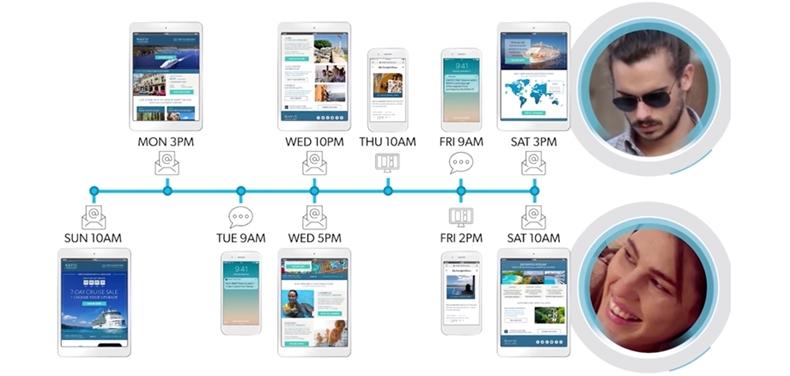There's so much talk about personalization in marketing, it feels like Groundhog Day (the Bill Murray movie, not Punxsutawney Phil).
And yet, for all the talk, many companies are still struggling to personalize email in a meaningful way (beyond adding a first name or a company, for example). Only 16% of marketers are "very" or "extremely" satisfied with the level of personalization in their marketing. (Where do you stand in comparison? Epsilon created this quiz to help you find your baseline.)
The problem with that low level of execution is that 90% of consumers say they find personalization appealing. And 80% of people are more likely to do business with a company that offers personalized experiences—which build trust and show customers that you value them.
So, ready or not, your customers want and expect personalized communications from your brand. Thankfully, there's a five-step framework you can use to kick your email marketing up a notch—whether you're starting from scratch or looking to move up to the big leagues.
1. Know your customers
The first step to meaningful personalization is to get to know your customers (maybe another phrase on repeat, but it's true).
Historically, our customer segments have been broad, using basic demographic information to fill consumers into buckets. The people in each bucket all "looked" the same, so they were all messaged the same.
Same offers, same content, same time of day.
To create personalized email experiences, however, you need a deeper look at each person, their behaviors, and their needs and preferences. You need to get to know the individuals inside the segments.
For example, in the past, Jeff and Rachel might have been placed in the same segment. But they're actually really different people.

The data you need to understand your customers at that level of detail is everywhere—and it's messy and not always easy to capture. If you don't have one yet, you need to build a realistic data capture and alignment strategy that integrates your online and offline data to get a full view of your customers.
Start with the basic level of data needed, and evolve in complexity over time; doing so will help to avoid paralysis analysis.
2. Speak to each person... personally
Once you've gotten to know your customers better and you recognize their differences, you can create personalized email experiences for each of them by having an ongoing dialogue, recognizing interactions (or lack thereof) at every touchpoint.
Many marketers struggle to move their contact strategies beyond the brand's marketing priorities—the top products the team wants to sell or the best offer they want to promote. Instead, you should customize email content, creative, and timing based on audience profiles and behaviors.
Let's take another look at Jeff and Rachel.
Jeff likes adventure and international travel. He also considers himself a foodie. You can catch his attention by appealing to what's trendy. On Saturdays, he's more likely to check his email in the afternoon.
With two kids at home, Rachel has different interests. She's always looking for a good deal and family-friendly activities. Her love of photography is a big motivator in planning a vacation. Rachel opens her weekend emails in the morning.
Everything about your emails to Jeff and Rachel should be personalized according to what you know about them, including their preferred send/receive time. It could look something like this:

A niche retailer we worked with at Epsilon took this approach to increase its contextual relevance and stand out in consumers' inboxes. By delivering emails at each individual's optimal send times, the retailer's click rate increased 7% and revenue grew 65%.
No worries if you're not there yet; the email channel is bursting with options for innovation. At a minimum, make sure your following design and coding best-practices to allow for email personalization.
Consider experimenting with subject line personalization (Coach has done some great work here), live content, and social integration. Personalization tactics like those transform your email from one-sided dialogue to meaningful conversation.
3. Learn and evolve with your customers throughout their journey
Unfortunately for us marketers, people change—as do their needs and preferences. That means you need to keep up with them as they evolve over time. You have to recognize every action—and inaction—across every ongoing touchpoint so you can anticipate what they'll be interested in tomorrow.
In other words, you need to understand each person's unique lifecycle to engage with them effectively along their journey.
You need to capture things like Jeff's recent engagement. You have to notice that Rachel has been researching a potential vacation online. You need to keep a real-time pulse on each person so that you can continue to have relevant conversations with that person—over time.
Cookies alone can't do this for you. Lifecycle personalization is a challenging step, but it is achievable with the right partner.
Look for a partner that can support your strategy with real-time customer insight and the ability to recognize individuals beyond the inbox, maintaining continuity of message and voice across devices and channels.
4. Align and optimize your channels
No one likes silos—especially not your customers, like Jeff and Rachel, who feel your internal silos in their external experiences. Just think back to that time Jeff got conflicting offers via email and digital ads, or when Rachel found a better offer in store than you sent her via email.
We'd all rather integrate our teams, programs, and messaging in the customer's best interest. Unfortunately, attribution requirements often pull you in the opposite direction: Each channel team is hungry to carve out a piece of the revenue pie.
To avoid that conflict, consider unifying teams to focus on the customer journey—regardless of the channel. Though you'll need executive-level support for that effort, the change allows for a more centralized, omnichannel approach to your marketing strategy.
5. Measure the impact of every conversation
You can't improve what you don't measure. If you're measuring only email opens and clickthroughs, you can't analyze and improve performance of more important email personalization metrics:
- Do your communications resonate with customers?
- What content inspires customers to act?
- Does your creative need to be reworked?
If you're stuck at this point, you need to take a step back to define what you're looking to accomplish. What are your business objectives for email personalization? Document those goals and then map them to KPIs and metrics.
Your opportunity lies in your ability to tell an ROI story beyond just the scope of an email campaign: how email personalization contributes to success across online and offline channels and how it ultimately adds to customer relationship value.
Build 1:You Relationships
Saying so may be repetitious or not, but we all still need to pay attention to personalization. Consumers are expecting it, and the brands that do it best will win their loyalty.
If you want to meet consumers' expectations for personalized email (or, heck, even blow them away), it comes down to knowing your customers more deeply and continuing to know them as they change. You use that understanding of them to personalize everything—content, creative, timing—then measure, optimize, and repeat.
If you're overwhelmed and you're not sure what to do next, it's helpful to start with a baseline. Take this interactive quiz today to find out where you and your brand are in your personalization journey—and where you should head next.




